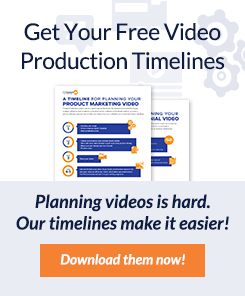Even the most confident people can get nervous when they sit down in front of a camera for a video interview. And the discomfort only intensifies when that little red light blinks on.
Bottom line: It's difficult for interview subjects to give you their best when they're uneasy, and that means it will be hard for you, the video producer and/or director, to get the best shots possible. Since nobody wants a sub-par product, there must be some ways to keep your subjects from freezing up, right?
Right! We've worked in video production for over 50 years and have learned plenty of tips and tricks in that time. Here are our top five ways to help video interview subjects feel at ease.
1. Do Your Homework.
Just because your interviewee is providing the answers doesn't mean she should feel pressure to control the content. Know what you want your subject to talk about before she sits down. That means doing research to find out the important subjects she should hit on so you can guide her to them when it comes time for questions.
Another huge benefit of doing your homework? Your interview subject can relax and take a more conversational tone, rather than worry about explaining all the details that may not be relevant or important.
Speaking of conversational, as an interviewer it's your job to engage and be engaged. A great interview should feel like it happened at the dinner table. Laugh, smile and have fun. If your interviewee is "caught in the head-lights" then your audience will feel like the car coming at them.
2. Talk Before the Shoot.
Whenever possible, don't let your first chat with the interviewee be during the interview. ;Try to develop some familiarity, even trust, with your subject by meeting informally or talking on the phone before the shoot. This is the time to let her know you only have her best interest in mind and will do everything possible to make her look and sound fantastic.
One way to do this is to explain as much as you can about the process before the interview date. You don't want to overwhelm the interviewee with too much information, you just want to let him know enough so there aren't any surprises that will catch him off guard at the shoot.
On that note, try not to yell “action!” Roll your records subtly so that moment between your intimate pre-conversation and your recorded interview is as invisible as possible.
3. Make the Subject, Not the Equipment, Your Star.
There's not much you can do about your camera's physical presence—it's got to be there and some people just can't help being daunted by it. But there are a few things you can do to minimize intimidating equipment. That little red light? Either turn it off or, if that's not possible, cover it with a bit of gaffer's tape.
Eye contact is critical, and can help set your subject at ease. Make all efforts to have your interviewee look at you, not the camera. Make a connection with that person and the camera will disappear.
And if your interviewee can't stop staring at the boom mic, see if you can use something smaller. Often times you can clip a small lav mic to your subject's shirt or jacket and the person will completely forget it's there after a few minutes.
4. Be Ready To Go Off Track.
Remember everything we said about research? No matter how much homework you do you can't plan for everything your subject might say. And that can actually be a good thing!
The key is to listen to your subject's answer. Don't just mechanically go through your questions, but listen, react, and interact. In short, be ready to go off track. If your interview subject reveals something unexpected and interesting, it's your job to keep pulling on the thread.
5. Take Your Time and Keep the Tape Rolling.
Always, always budget for more time than you think you should take. Your interviewee will be happy to know that there's room in the schedule to do as many takes are as needed—and you might really need them! Use the first few minutes as a warm up to make small talk and ease into things. Plus, in our experience, subjects tend to become more relaxed in an interview as time goes on, so your best cuts might come at the very end.
On that note, don't shut off the camera after you've asked your last question. We've lost count of how many times we've gotten gems from unplanned content that comes out after the interviewee thinks the interview is over!
We hope these tips make your next video interviews better than ever—not just for your interviewees' sake, but for yours too!
